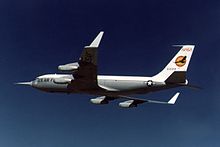Aircraft Video Profile: Boeing KC-135 Stratotanker

Published by Vref.org
The Boeing KC-135 Stratotanker is a military aerial refueling aircraft. It and the Boeing 707 airliner were developed from the Boeing 367-80 prototype. The KC-135 was the US Air Force’s first jet-powered refueling tanker and replaced the KC-97 Stratotanker. The KC-135 was initially tasked to refuel strategic bombers, but was used extensively in the Vietnam War and later conflicts such as Operation Desert Storm to extend the range and endurance of US tactical fighters and bombers.
See Flight Video – Click
The KC-135 entered service with the United States Air Force (USAF) in 1957; it is one of six military fixed-wing aircraft with over 50 years of continuous service with its original operator. The KC-135 is supplemented by the larger KC-10. Despite increased maintenance costs, studies conclude many of the aircraft could be flown until 2040. The aircraft will eventually be replaced by the Boeing KC-46 Pegasus.
Development
Background
 Like its sibling, the commercial Boeing 707 jet airliner, the KC-135 was derived from the Boeing 367-80 jet transport “proof of concept” demonstrator, which was commonly called the “Dash-80”. The KC-135 is similar in appearance to the 707, but has a narrower fuselage and is shorter than the 707. The KC-135 predates the 707, and is structurally quite different from the civilian airliner. Boeing gave the future KC-135 tanker the initial designation Model 717.[1]
Like its sibling, the commercial Boeing 707 jet airliner, the KC-135 was derived from the Boeing 367-80 jet transport “proof of concept” demonstrator, which was commonly called the “Dash-80”. The KC-135 is similar in appearance to the 707, but has a narrower fuselage and is shorter than the 707. The KC-135 predates the 707, and is structurally quite different from the civilian airliner. Boeing gave the future KC-135 tanker the initial designation Model 717.[1]
In 1954 USAF’s Strategic Air Command (SAC) held a competition for a jet-powered aerial refueling tanker. Lockheed’s tanker version of the proposed Lockheed L-193 airliner with tail-mounted engines was declared the winner in 1955.[2][verification needed] Since Boeing’s proposal was already flying, the KC-135 could be delivered two years earlier and Air Force Secretary Harold E. Talbott ordered 250 KC-135 tankers until the Lockheed’s design could be manufactured. In the end, orders for the Lockheed tanker were dropped rather than supporting two tanker designs. Lockheed never produced its jet airliner, while Boeing would eventually dominate the market with a family of airliners based on the 707.[3][4]
In 1954 the Air Force placed an initial order for 29 KC-135As, the first of an eventual 820 of all variants of the basic C-135 family. The first aircraft flew in August 1956 and the initial production Stratotanker was delivered to Castle Air Force Base, California, in June 1957. The last KC-135 was delivered to the Air Force in 1965.
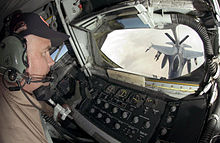
USAF KC-135R boom operator view
Developed in the early 1950s, the basic airframe is characterized by 35-degree aft swept wings and tail, four underwing-mounted engine pods, a horizontal stabilizer mounted on the fuselage near the bottom of the vertical stabilizer with positive dihedral on the two horizontal planes and a hi-frequency radio antenna which protrudes forward from the top of the vertical fin or stabilizer. These basic features make it strongly resemble the commercial Boeing 707 and 720 aircraft, although it is actually a different aircraft.
Reconnaissance and command post variants of the aircraft, including the RC-135 Rivet Joint and EC-135 Looking Glass aircraft were operated by SAC from 1963 through 1992, when they were reassigned to the Air Combat Command (ACC). The USAF EC-135 Looking Glass was subsequently replaced in its role by the U.S. Navy E-6 Mercury aircraft, a new build airframe based on the Boeing 707-320B.
General upgrades

A Cold War-era image of B-52D refueling from a KC-135A
The KC-135Q variant was modified to carry JP-7 fuel necessary for the SR-71 Blackbird, segregating the JP-7 from the KC-135’s own fuel supply (the body tanks carrying JP-7, and the wing tanks carrying JP-4 or JP-8). When the KC-135Q model received the CFM-56 engines, it was redesignated the KC-135T model, which was capable of separating the main body tanks from the wing tanks where the KC-135 draws its engine fuel. The only external difference between a KC-135R and a KC-135T is the presence of a clear window on the underside of the empennage of the KC-135T where a remote controlled searchlight is mounted. It also has two ground refueling ports, located in each rear wheel well so ground crews can fuel both the body tanks and wing tanks separately.
Eight KC-135R aircraft are receiver-capable tankers, commonly referred to as KC-135R(RT). All eight aircraft were with the 22d Air Refueling Wing at McConnell AFB, Kansas, in 1994.[5] They are primarily used for force extension and Special Operations missions, and are crewed by highly qualified receiver capable crews. If not used for the receiver mission, these aircraft can be flown just like any other KC-135R.
In order to expand the KC-135’s capabilities and improve its reliability, the aircraft has undergone a number of upgrades. Among these was the Pacer-CRAG program (CRAG=Compass, Radar And GPS) which ran from 1999 to 2002 and modified all the aircraft in the inventory to eliminate the Navigator position from the flight crew. The program development was done by Rockwell Collins in Iowa[6] and installation was performed by BAE Systems at the Mojave Airport in California.[7] The latest block upgrade to the KC-135 is Block 40.5 which allows the KC-135 to comply with Global air-traffic management. The KC-135 Block 45 program is expected to come online in 2014 and addresses non-procurable instrument upgrades as well as a new autopilot system.
Re-engining[edit]
All KC-135s were originally equipped with Pratt & Whitney J-57-P-59W turbojet engines which produced 10,000 lbf (44 kN) of thrust dry, and approximately 13,000 lbf (58 kN) of thrust wet. Wet thrust is achieved through the use of water injection on takeoff. 670 US gallons (2,500 L) of water are injected into the engines over the course of two and a half minutes. This water allows a second set of fuel injectors to activate without melting the turbine buckets. The water turns to steam and is ejected out the rear of the engine, increasing the exhaust mass and increasing thrust. The engine runs somewhat hotter, with more engine noise.
In the 1980s the first modification program re-engined 157 Air Force Reserve (AFRES) and Air National Guard (ANG) tankers with the Pratt & Whitney TF-33-PW-102 engines from 707 airliners retired in the late 1970s and early 1980s. The re-engined tanker, designated the KC-135E, was 14% more fuel efficient than the KC-135A and could offload 20% more fuel on long duration flights. (The difference is that the A-model weighed only 104,000 lb (47,000 kg) empty, while the E-model weighed 115,000 lb (52,000 kg) empty. But the maximum takeoff weight was not increased for the E-model. Therefore, the A-model could takeoff with 200,000 lb (91,000 kg) of fuel, while the E-model could only takeoff with 190,000 lb (86,000 kg) of fuel.) Only the KC-135E aircraft were equipped with thrust-reversers for takeoff aborts and shorter landing roll-outs. The KC-135E fleet has since either been re-engined into the R-model configuration or placed into long term storage (“XJ”), as Congress has prevented the Air Force from formally retiring them. The final KC-135E, tail number 56-3630, was delivered by the 101st Air Refueling Wing of the Maine Air National Guard to the 309th Aerospace Maintenance and Regeneration Group (AMARG) at Davis-Monthan Air Force Base in September 2009.[8]

A nose-on view of several re-enginedKC-135R aircraft taxiing prior to takeoff. The new engines are CFM56-2 high-bypass turbofans.
The second modification program re-engined 500 aircraft with new CFM International CFM56 (military designation: F108) engines produced by General Electric and Snecma. The CFM-56 turbofans are capable of producing approximately 22,500 lbf (100 kN) of thrust, nearly a 100% increase in thrust compared to the original J-57 engines. The re-engined tanker, designated either the KC-135R (modified KC-135A or E) or KC-135T (modified KC-135Q), can offload up to 50% more fuel (on a long duration sortie), is 25% more fuel efficient, costs 25% less to operate and is 96% quieter than the KC-135A (sideline noise levels at takeoff were reduced from 126 to 99 decibels).[9]
The KC-135R’s operational range is 60% greater than the KC-135E for comparable fuel offloads, providing a wider range of basing options.[10]
No longer in consideration, upgrading the remaining KC-135Es into KC-135Rs would have cost about US$3 billion, about $24 million per aircraft.[10] According to Air Force data, the KC-135 fleet had a total operation and support cost in fiscal year 2001 of about $2.2 billion. The older E model aircraft averaged total costs of about $4.6 million per aircraft, while the R models averaged about $3.7 million per aircraft. Those costs include personnel, fuel, maintenance, modifications, and spare parts.[11]
Further upgrades and derivatives
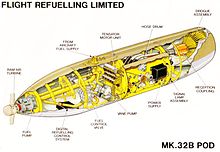
Cutaway of the Flight Refueling Limited Mk.32B Refueling Pod.
The Multi-point Refueling Systems (MPRS) modification adds refueling pods to the KC-135’s wings. The pods allow refueling of U.S. Navy, U.S. Marine Corps and most NATO tactical jet aircraft while keeping the tail-mounted refueling boom. The pods themselves are Flight Refueling Limited (FRL) MK.32B model pods. This allows the tanker to refuel two receivers at the same time, which increases throughput compared to the boom drogue adapter.[12]
A number of KC-135A and KC-135B aircraft have been modified to EC-135, RC-135 and OC-135 configurations for use in several different roles.
Design
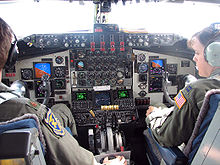
Flight deck of KC-135R; instrument panel has been modified under the Pacer-CRAG program
The KC-135R has four turbofan engines, mounted under 35-degree swept wings,[13] which power it to takeoffs at gross weights up to 322,500 pounds (146,300 kg). Nearly all internal fuel can be pumped through the tanker’s flying boom, the KC-135’s primary fuel transfer method. A special shuttlecock-shaped drogue, attached to and trailing behind the flying boom, may be used to refuel aircraft fitted with probes. A boom operator stationed in the rear of the aircraft controls the boom while lying prone. A cargo deck above the refueling system can hold a mixed load of passengers and cargo. Depending on fuel storage configuration, the KC-135 can carry up to 83,000 pounds (38,000 kg) of cargo.
Operational history
Introduction into service[edit]
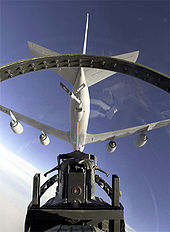
An F-15 backs out after refueling from a KC-135R.
The KC-135 was initially purchased to support bombers of the Strategic Air Command, but by the late 1960s, in the Southeast Asia theater, the KC-135 Stratotanker’s ability as a force multiplier came to the fore. Midair refueling of F-105 and F-4 fighter-bombers as well as B-52 bombers brought far-flung bombing targets within reach, and allowed fighter missions to spend hours at the front, rather than just a few minutes, due to their limited fuel reserves. KC-135 crews refueled both Air Force and Navy / Marine Corps aircraft, though they would have to change to probe and drogue adapters depending upon the mission. Crews also helped to bring in damaged aircraft which could fly while being fed by fuel to a landing site. KC-135s continued their tactical support role in later conflicts such as Desert Storm and current aerial strategy.
The Strategic Air Command (SAC) had the KC-135 Stratotanker in service with Regular Air Force SAC units from 1957 through 1992 and with SAC-gained Air National Guard (ANG) and Air Force Reserve (AFRES) units from 1975 through 1992.[citation needed] Following a major USAF reorganization that resulted in the inactivation of SAC in 1992, most KC-135s were reassigned to the newly created Air Mobility Command (AMC). While AMC gained the preponderance of the aerial refueling mission, a small number of KC-135s were also assigned directly to United States Air Forces in Europe (USAFE), Pacific Air Forces (PACAF) and the Air Education and Training Command (AETC). All Air Force Reserve Command (AFRC) KC-135s and most of the Air National Guard (ANG) KC-135 fleet became operationally-gained by AMC, while Alaska Air National Guard andHawaii Air National Guard KC-135s became operationally-gained by PACAF.[citation needed]
Air Mobility Command (AMC) manages more than 481 Stratotankers, of which the Air Force Reserve Command (AFRC) and Air National Guard (ANG) fly 292 in support of AMC’s mission as on April 2008.[14]
The KC-135 is joined by the Tupolev Tu-95, the C-130 Hercules, the B-52 Stratofortress, the English Electric Canberra, the Northrop T-38 Talon and the Lockheed U-2 in having over 50 years of continuous service with its original operator.[citation needed]
Israel was offered KC-135s again in 2013, after turning down the aging aircraft twice due to expense of keeping them flying.[15][16] The IAF again rejected the offered KC-135Es, but said that it would consider up to a dozen of the newer KC-135Rs.[17]
Research usage
KC-135 winglet flight tests at Dryden Flight Research Center.
Besides its primary role as an inflight aircraft refueler, the KC-135, designated NKC-135, has assisted in several research projects at the NASA Dryden Flight Research Center atEdwards Air Force Base, California. One such project occurred between 1979 and 1980 when special wingtip “winglets”, developed by Richard Whitcomb of the Langley Research Center, were tested at Dryden, using an NKC-135A tanker loaned to NASA by the Air Force. Winglets are small, nearly vertical fins installed on an aircraft’s wing tips. The results of the research showed that drag was reduced and range could be increased by as much as 7 percent at cruise speeds.[18][19] Winglets are now being incorporated into most new commercial and military transport jets, as well as business aviation jets.
NASA also has operated several KC-135 aircraft (without the tanker equipment installed) as their infamous Vomit Comet zero-gravity simulator aircraft. The longest-serving (1973 to 1995) version was KC-135A, AF Ser. No. 59-1481, named Weightless Wonder IV and registered as N930NA.[20]
Replacing the KC-135
In 2006, the KC-135E fleet was flying an annual average of 350 hours per aircraft and the KC-135R fleet was flying an annual average of 710 hours per aircraft. The KC-135 fleet is currently flying double its planned yearly flying hour program to meet airborne refueling requirements, and has resulted in higher than forecast usage and sustainment costs.[21]
The Air Force projects that E and R models have lifetime flying hour limits of 36,000 and 39,000 hours, respectively. According to the Air Force, only a few KC-135s would reach these limits before 2040, but at that time some of the aircraft would be about 80 years old. The Air Force estimates that their current fleet of KC-135s have between 12,000 to 14,000 flying hours on them-only 33 percent of the lifetime flying hour limit.[22]Nevertheless these aircraft are over 40 years old and maintenance costs are increasing, with airframe corrosion being the worst problem.
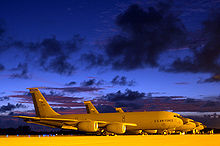
KC-135Rs at twilight on the flightline
Between 1993 and 2003, the amount of KC-135 depot maintenance work doubled, and the overhaul cost per aircraft tripled.[23] In 1996 it cost $8,400 per flight hour for the KC-135, and in 2002 this had grown to $11,000. The Air Force’s 15-year cost estimates project further significant growth through fiscal year 2017. For example, operations and support costs for the KC-135 fleet are estimated to grow from about $2.2 billion in fiscal year 2003 to $5.1 billion (2003 dollars) in fiscal year 2017, an increase of $2.9 billion, or over 130 percent, which represents an annual growth rate of about 6.2 percent.[24] In March 2009 the Air Force indicated that KC-135s would require additional skin replacement to allow their continued use beyond 2018.[25]
The USAF decided to replace the KC-135 fleet. However, the KC-135 fleet is large and will need to be replaced gradually. Initially the first batch of replacement planes was to be an air tanker version of the Boeing 767, leased from Boeing. In 2003, this was changed to contract where the Air Force would purchase 80 KC-767 aircraft and lease 20 more.[26] In December 2003, the Pentagon froze the contract and in January 2006, the KC-767 contract was canceled. This followed public revelations of corruption in how the contract was awarded, as well as controversy regarding the original leasing rather than outright purchase agreement. Then Secretary of Defense Rumsfeld stated that this move will in no way impair the Air Force’s ability to deliver the mission of the KC-767, which will be accomplished by continuing upgrades to the KC-135 and KC-10 Extender fleet.
In January 2007, the U.S. Air Force formally launched the KC-X program with a request for proposal (RFP). KC-X is first phase of three acquisition programs to replace the KC-135 fleet.[27] On 29 February 2008, the US Defense Department announced that it had selected the EADS/Northrop Grumman “KC-30” (to be designated the KC-45A) over the Boeing KC-767.[28] On 18 June 2008, the US Government Accountability Officesustained Boeing’s protest of the selection of the Northrop Grumman/EADS’s tanker.[29] In 2010, the US Air Force restarted the KC-X competition with the release of a revised request for proposal (RFP).[30] After evaluating bids, the USAF selected the Boeing 767 design, with the military designation KC-46, as a replacement in February 2011.[31]
Variants
See Boeing C-135 Stratolifter for further details on the C-135 family.
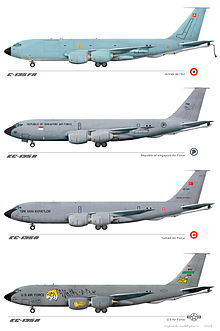
Active KC-135 aircraft liveries
- KC-135A
- Original production version powered by four Pratt & Whitney J57s, 732 built. Given the Boeing model numbers 717-100A, 717-146 and 717-148.[32]
- NKC-135A
- Test-configured KC-135A.
- KC-135B
- Airborne command post version with 17 built equipped with turbofan engines. Provided with in-flight refueling capability and redesignated EC-135C.[33] Given the model number 717-166.[32]
- KC-135D
- All four RC-135As (Pacer Swan) were modified to partial KC-135A configuration in 1979.[34][35] The four aircraft (serial numbers 63-8058, 63-8059, 63-8060 and 63-8061) were given a unique designation KC-135D as they differed from the KC-135A in that they were built with a flight engineer’s position on the flight deck.[36] The flight engineer’s position was removed when the aircraft were modified to KC-135 standards but they retained their electrically powered wing flap secondary (emergency) drive mechanism and second air conditioning pack which had been used to cool the RC-135As on-board photo-mapping systems.[37] Later re-engined with Pratt & Whitney TF33 engines and a cockpit update to KC-135E standards in 1990 and are were retired to the 309th AMARG at Davis-Monthan AFB, AZ in 2007.[35][38]
- KC-135E
- Air National Guard and Air Force Reserve KC-135As re-engined with Pratt & Whitney TF-33-PW-102 engines from retired 707 airliners (161 modified). All E model aircraft were retired to the 309th AMARG at Davis-Monthan AFB by September 2009 and replaced with R models.[8][39]
- NKC-135E
- Test-configured KC-135E.
- KC-135Q
- KC-135As modified to carry JP-7 fuel necessary for the SR-71 Blackbird, 56 modified,[33] survivors to KC-135T.
- KC-135R (1960s)
- 4 JC/KC-135As converted to Rivet Stand (Later Rivet Quick) configuration for reconnaissance and evaluation of above ground nuclear test (55-3121, 59-1465, 59-1514, 58-0126, 58-0126 replaced 59-1465 after 59-1465 crashed in 1965). These aircraft were powered by Pratt & Whitney J57 Engines and were based at Offutt AFB, Nebraska.
- KC-135R
- KC-135As and some KC-135Es re-engined with CFM-56 engines, at least 361 converted.
- KC-135R(RT)
- Receiver-capable KC-135R Stratotanker, 8 modified with either a Boeing or LTV receiver system and a secure voice SATCOM radio.
- KC-135T
- KC-135Q re-engined with CFM-56 engines, 54 modified.
- EC-135Y
- An airborne command post modified in 1984 to support CINCCENT. Aircraft 55-3125 was the only EC-135Y. Unlike its sister EC-135N, it was a true tanker that could also receive in-flight refueling. Pratt & Whitney TF-33-PW-102. Currently retired to 309th AMARG at Davis-Monthan AFB, AZ.

